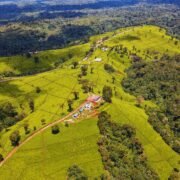
The Ultimate Guide to Tsavo East and West: Red Elephants, Lava Fields, and Hidden Safaris
Introduction to Tsavo: A Wildlife Enthusiast’s Dream
The Tsavo East and West National Parks represent one of Africa’s largest protected areas, spanning over 22,000 square kilometers. These national parks, situated in the eastern region of Kenya, offer a remarkable mix of diverse landscapes, ranging from arid savannahs to lush riverbanks and imposing volcanic formations. This unique combination not only makes the parks a vital ecosystem for conservation efforts but also one of the most sought-after safari destinations in Kenya.
Tsavo East is renowned for its iconic red elephants, whose distinctive coloration is a product of the red ochre soil in the region. These gentle giants can often be seen foraging in the plains, creating a breathtaking spectacle that attracts many visitors. On the other hand, Tsavo West is famous for its dramatic scenery, featuring the Shetani lava flow and the Chaimu crater hike, which allow tourists to immerse themselves in geological wonders while exploring African wildlife photography opportunities. As one moves through the parks, one can encounter a wide array of wildlife, including the Big Five, making Tsavo a prime location for those eager to discover the richness of Kenya’s natural heritage.
The parks also hold significant importance due to their role in sustainable tourism and wildlife conservation. With numerous safari lodges in Tsavo providing luxurious accommodations, visitors can enjoy the best safaris in Kenya while contributing to local conservation efforts. Additionally, the Ngulia Rhino Sanctuary within Tsavo West focuses on the protection of the endangered rhinoceros, exemplifying the commitment to preserving Kenya’s unique wildlife. Furthermore, Tsavo’s rich avifauna makes it a hotspot for birdwatching enthusiasts, drawing attention to the lesser-known but equally captivating attractions of these national parks.
The Fascinating Red Elephants of Tsavo
Tsavo East National Park and Tsavo West National Park are renowned for their unique population of red elephants, whose distinct coloration can be attributed to the iron-rich red soils of the region. This reddish hue not only serves as a natural sunscreen, protecting the elephants from the harsh African sun, but also sets them apart as a captivating subject for wildlife enthusiasts and photographers visiting Kenya safari destinations.
These remarkable animals display intricate social structures similar to those found in other elephant populations. Matriarchs often lead herds, guiding younger elephants and ensuring the transmission of knowledge essential for survival. The family bonds within these herds are strong, with elephants displaying complex emotional behaviors such as grief and joy. Observing the interactions of these red elephants during a Tsavo wildlife safari offers captivating insights into their behavior, particularly the ways they communicate and nurture their young.
However, the red elephants of Tsavo face numerous challenges, including habitat loss and poaching. These threats have contributed to the decline of their population, prompting significant conservation efforts aimed at protecting them. Initiatives within the Tsavo ecosystem focus on habitat preservation and effective anti-poaching measures. For instance, the Ngulia Rhino Sanctuary provides a safe haven not just for rhinos but also acts as a protective corridor for various wildlife, including the red elephants.
Additionally, educating local communities about the importance of these giant mammals is crucial for their survival. By engaging in offbeat African safaris and supporting Tsavo tour packages that include conservation efforts, visitors can play a role in preserving the legacy of the red elephants. The unique appeal of these animals contributes to the allure of Tsavo attractions, drawing nature lovers eager to witness their majesty in their natural habitat.
Spectacular Landscapes: Lava Fields and Scenic Vistas
The Tsavo East and West National Parks in Kenya are known for their stunning geological features, which encompass a diverse range of landscapes, from expansive savannahs to formidable mountain ranges. One of the most iconic aspects of these parks is the presence of ancient lava fields that have shaped the environment over centuries, offering a unique backdrop for various wildlife species, including the infamous red elephants in Kenya.
The Shetani Lava Flow, located in Tsavo West, is a prime example of this volcanic activity. Formed by an eruption from the nearby Chyulu Hills, this blackened terrain stretches for miles and is dotted with fascinating rock formations and unique vegetation. The stark contrast between the dark lava and the vibrant green flora provides a captivating scene for visitors and an exceptional opportunity for African wildlife photography.
In addition to the lava fields, the Tsavo parks feature rugged mountains, like the Ngulia Hills, which offer breathtaking panoramic views of the surrounding landscapes. As you ascend, you may encounter the Ngulia Rhino Sanctuary, a key conservation area aimed at protecting the endangered black rhinoceros. The varying elevation promotes diverse ecosystems, fostering a rich biodiversity that visitors can experience during a Tsavo wildlife safari.
Another remarkable sight is the Mzima Springs in Tsavo West, where crystal-clear water emerges from the ground, creating an oasis that attracts numerous bird species and other wildlife. Visitors to this region can enjoy leisurely walks along the trails and observe wildlife congregating around the refreshing waters. The Chaimu Crater hike also draws adventurers seeking both exercise and stunning views of the surrounding area.
Overall, the geological features of Tsavo East and West not only provide a stunning backdrop for safaris, but they also support a variety of wildlife and attract nature enthusiasts from around the world. Whether one is interested in Tsavo birdwatching or exploring the best safaris in Kenya, these national parks encompass some of Africa’s most picturesque landscapes.
Hidden Safaris: Exploring Off the Beaten Path
When it comes to safari experiences, many travelers often gravitate towards the popular attractions within Tsavo East and Tsavo West national parks. However, delving into lesser-known routes can offer a unique glimpse into the rich tapestry of wildlife and scenery that magnifies these Kenyan national parks. Exploring off the beaten path allows visitors to witness the stunning landscapes of Tsavo, characterized by distinct features such as Mzima Springs and the mesmerizing Shetani Lava Flow.
Choosing offbeat African safaris can enhance the wildlife experience significantly. These alternatives not only provide the chance to discover the elusive red elephants in Kenya but also allow guests to encounter a diversified array of safari wildlife, from majestic lions to the rare black rhino at the Ngulia Rhino Sanctuary. The tranquility that comes with fewer tourists also paves the way for authentic wildlife photography, where capturing the essence of African wildlife becomes a possibility rather than just a mere experience.
Moreover, exploring hidden safaris can unveil the charm of activities like the Chaimu Crater hike, which rewards adventurous travelers with breathtaking views over the surrounding plains. As guides lead safari enthusiasts through less-traveled routes, the opportunity arises to learn about the intricate ecosystem and the delicate balance of nature within Tsavo’s hidden gems.
For those planning their itineraries, it is crucial to select reliable tour packages that cater specifically to off-the-beaten-path adventures. Engaging with experienced local guides, who are familiar with the hidden attractions and wildlife hotspots, can make all the difference in ensuring a memorable safari experience. For travelers seeking a truly personal and immersive adventure, these hidden safaris in Tsavo promise to reveal the park’s untamed spirit and majestic natural beauty.
Best Time to Visit: Seasonal Highlights
When planning a trip to Tsavo East National Park and Tsavo West National Park, understanding the seasonal highlights is essential for an enriching experience. Generally, the best times to visit these iconic Kenya safari destinations are during the dry seasons, which occur from June to October and from January to February. These months provide optimal wildlife viewing opportunities, as animals gather around the remaining water sources, making it easier to spot the famous red elephants in Kenya, along with other wildlife.
During the dry season, the skies are generally clear, allowing for excellent conditions for African wildlife photography. In contrast, the wet season, from March to May, can restrict access to certain areas, although it also brings lush landscapes and vibrant flora. This period offers the chance to see baby animals and the rejuvenation of wildlife habitats. Additionally, the rains typically result in fewer tourists, creating a more tranquil atmosphere in the parks.
In terms of specific events, the Great Migration is not a focal point of Tsavo, yet the park’s diverse ecosystems offer unique experiences such as birdwatching from late October through December when migratory birds are present. Highlights also include blooming periods when flora flourishes, showcasing the beauty of the Tsavo attractions, including Mzima Springs and the Shetani Lava Flow.
However, visitors should be aware of the pros and cons of peak and off-peak seasons. While peak seasons provide the best wildlife visibility, they also attract larger crowds and higher prices for safari lodges in Tsavo. Conversely, visiting off-peak can lead to solitude and cost savings but may limit wildlife sightings during certain months. Therefore, planning ahead and considering these factors will ensure a memorable Tsavo wildlife safari experience tailored to individual preferences.
Accommodation Options: From Luxury Lodges to Campsites
When planning a visit to Tsavo East National Park and Tsavo West National Park, choosing suitable accommodation is paramount to ensure a comfortable and memorable experience. The parks offer a wide range of options that cater to various budgets and preferences, making it one of the most appealing Kenya safari destinations.
For travelers seeking luxury, there are several safari lodges in Tsavo that provide opulent amenities and breathtaking views of the surrounding landscapes. These lodges often feature spacious rooms with elegant décor, private balconies, and swimming pools, allowing guests to unwind after a day of exploring the unique wildlife, including the famous red elephants in Kenya. While prices at these lodges can be higher, the level of service and opportunities for exclusive experiences, such as guided safaris and private dining, make them a worthwhile investment for discerning travelers.
On the other hand, there are budget-friendly campsites that provide the opportunity for a more immersive experience in nature. These campsites offer essential amenities while allowing guests to connect with the wilderness. They often come with communal bathrooms and cooking facilities, catering to adventurous travelers who prefer self-catering during their stay. These options are excellent for families or groups seeking to save costs. One downside to camping, however, is the lack of luxury comforts that many travelers may prefer.
For those interested in unique experiences, tented camps provide a middle ground. These establishments blend comfort with wilderness, allowing guests to sleep under canvas while enjoying amenities akin to a lodge. Regardless of the chosen accommodation, whether it be a trip to the spectacular Mzima Springs or the impressive Shetani Lava Flow, options abound to accommodate every type of traveler.
Beyond the Animals: Cultural Experiences in Tsavo
While the allure of Tsavo East National Park and Tsavo West National Park often centers on the unique wildlife, including the famed red elephants in Kenya, visitors are also presented with enriching cultural experiences that deepen understanding of the region’s heritage. Engaging with local communities during your Tsavo wildlife safari offers a chance not only to witness the marvels of nature but also to appreciate the vibrant cultures that coexist alongside them.
Responsible tourism plays a vital role in these interactions, ensuring that the local communities benefit from visitors’ presence. Many tour operators include cultural excursions in their tour packages, allowing guests to visit nearby villages, participate in traditional ceremonies, or learn about local art and crafts. Such experiences not only contribute to the economic development of the communities but also foster mutual respect and understanding between visitors and locals.
One notable cultural highlight is the opportunity to join community-based initiatives that focus on wildlife conservation. These programs educate travelers about the importance of sustainable practices and the challenges faced by both wildlife and local populations. By participating in these initiatives, visitors can grasp the intricate relationship between human livelihoods and the iconic landscapes of Kenyan national parks.
Additionally, Tsavo offers cultural sites that reflect the rich history of the region. The nearby Ngulia Rhino Sanctuary is not just pertinent for wildlife enthusiasts but also for those interested in conservation efforts that involve local people. Engaging with these efforts during your stay enhances the overall safari experience, allowing travelers to appreciate the broader context of their journey.
Thus, a visit to Tsavo is not solely about spotting the Big Five in Kenya or capturing stunning scenes through African wildlife photography; it should also encompass learning about the local communities and their traditions. This balanced approach fosters an immersive experience that transcends the typical safari, making your journey through Tsavo truly unforgettable.
Preparing for Your Adventure: Tips and Essentials
Embarking on a journey to Tsavo East National Park and Tsavo West National Park can be a thrilling experience, as these regions are famous for their stunning landscapes, unique wildlife, and the iconic red elephants in Kenya. To ensure a successful and enjoyable adventure, it is important to adequately prepare. Here are some essential tips for your visit.
First, consider packing appropriate clothing that accommodates the climate. Light, breathable fabrics are suitable for daytime temperatures, while warmer layers are recommended for cooler evenings. Sturdy hiking boots can enhance your comfort during the Tsavo wildlife safari, especially when exploring areas such as Shetani Lava Flow or hiking to the Chaimu Crater. Don’t forget sun protection—hats, sunglasses, and sunscreen are indispensable.
During your safari, safety should remain a priority. Always adhere to guidelines provided by your tour guide and maintain a reasonable distance from wildlife to avoid distressing the animals. Many safari lodges in Tsavo emphasize responsible wildlife viewing, which is essential for conservation efforts and visitor safety. Engaging in tours that focus on offbeat African safaris can also lead to unique wildlife sightings and enrich your overall experience.
Health considerations cannot be overlooked. It is advisable to consult a healthcare professional regarding vaccinations and medications, particularly for malaria and any other diseases prevalent in the region. Travelers should also carry a basic first-aid kit and any personal medications. As part of your planning, familiarize yourself with necessary permits or regulations that may apply to your visit to Kenyan national parks, especially if you plan to participate in organized Tsavo tour packages.
In conclusion, thorough preparation can enhance your experience in Tsavo East and West, enabling you to enjoy the breathtaking landscapes, exciting wildlife, and the rich cultural heritage that define these remarkable Kenya safari destinations.
Conclusion: Embrace the Wild Spirit of Tsavo
In conclusion, Tsavo East and West National Parks offer a remarkable array of experiences that truly embody the wild spirit of Kenya. From witnessing the iconic red elephants in Kenya to exploring the enchanting Mzima Springs, both parks provide extraordinary opportunities for adventure and discovery. Whether you are on a Tsavo wildlife safari or indulging in African wildlife photography, the diverse landscapes and vibrant ecosystems will leave a lasting impression on every visitor.
One of the major attractions in Tsavo is the Shetani Lava Flow, an awe-inspiring geological feature that illustrates the dramatic interactions between nature and time. Hikers can also engage in the Chaimu Crater hike, which provides breathtaking views of the surrounding regions. For bird enthusiasts, Tsavo birdwatching is a delight, as the parks host a wide range of avian species, making it a top consideration among various Kenya safari destinations.
Visitors can choose from numerous safari lodges in Tsavo, ensuring a comfortable stay while they soak in the natural beauty surrounding them. The allure of the Big Five in Kenya adds another dimension to the experience, allowing safari-goers to encounter these magnificent creatures in their natural habitat. Additionally, at the Ngulia Rhino Sanctuary, guests can contribute to vital conservation efforts aimed at protecting endangered species.
It is essential for all visitors to consider their impact on such pristine environments and seek ways to contribute positively to the ecosystems they explore. By choosing responsible tourism options and supporting local conservation initiatives, travelers can ensure that the beauty and diversity of Tsavo’s wildlife and landscapes endure for future generations. Embrace the spirit of adventure that Tsavo offers and create unforgettable memories in one of Kenya’s most remarkable national parks.






